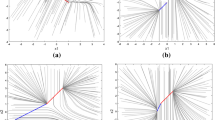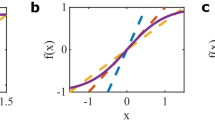Abstract
Multistable neural networks have attracted much interests in recent years, since the monostable networks are computationally restricted. This paper studies a N linear threshold neurons recurrent networks without Self-Excitatory connections. Our studies show that this network performs a Winner-Take-All (WTA) behavior, which has been recognized as a basic computational model done in brain. The contributions of this paper are: (1) It proves by mathematics that the proposed model is Non-Divergent. (2) An important implication (Winner-Take-All) of the proposed network model is studied. (3) Digital computer simulations are carried out to validate the performance of the theory findings.
Similar content being viewed by others
Explore related subjects
Discover the latest articles, news and stories from top researchers in related subjects.References
Hartline HK, Ratliff F (1958) Spatial summation of inhibitory influence in the eye of limulus and the mutual interaction of receptor units. J Gen Physiol 41: 1049–1066
Salinas A, Abbott LF (1996) A model of multiplicative responses in parietal cortex. Proc Nat Acad Sci USA 93: 11956–11961
Adorjan P, Levitt LB, Lund JS, Obermayer K (1999) A model for the intracortical origin of orientation preference and tuning in macaque striate cortex. Vis Neurosci 16: 303–318
Hahnloser RLT, Sarpeshkar R, Mahowald MA, Douglas R, Seung H (2000) Digital selection and analogue amplification coexist in a cortexinsired silicon circuits. Nature 405: 947–951
Wersing H, Beyn WJ, Ritter H (2001) Dynamical stability conditions for recurrent neural networks with unstarturating piecewise linear transfer functions. Neural comput 13: 1811–1825
Hopfield JJ, Tank DW (1985) Neural computation of decisions in optimization problems. Biol Cybern 52: 141–152
Chua LO, Yang L (1998) Cellular neural networks: theory. EEE Trans Circuits Syst 35(12): 1257–1272
Feng J, Pan H, Roychowdhury VP (1996) On neurodynamics with limiter function and Linsker’s development model. Neural comput 8: 1003–1019
Douglas R, Koch C, Mahowald M, Martin K, Suarez H (1995) Recurrent excitation in neocortical circuits. Science 269: 981–985
Feng J, Hadeler K (1996) Qualitative behaviour of some simple networks. J Phys A 29: 5019–5033
Kuhn D, Loehwen R (1987) Piecewise affine bijections of R n, and the equation Sx + − Tx − = y. Linear Algebra Appl 96: 109–129
Yi Z, Tan KK (2002) Dynamic stability conditions for Lotka-Volterra recurrent neural networks with delays. Phys Rev E 66: 1–8
Wersing H, Steil JJ, Ritter H (2001) A competitive-layer model for feature binding and sensory segmentation. Neural comput 13: 357–387
Yi Z, Tan KK, Lee TH (2003) Multistability analysis for recurrent neural networks with unsaturating piecewise linear transfer functions. Neural Comput 15: 639–662
Yi Z, Tan KK (2004) Multistability of discrete-time recurrent neural networks with unsaturating piecewise linear transfer functions. IEEE Trans Neural Netw 15(2): 329–336
Tan KC, Tang HJ, Zhang WN (2004) Qualitative analysis for recurrent neural networks with linear threshold transfer functions. IEEE Trans Circuits Syst 52(5): 1003–1012
Tang HJ, Tan KC, Zhang WN (2005) Analysis of cyclic dynamics for networks of linear threshold neurons. Neural Comput 17: 97–114
Hahnloser RLT (1998) On the piecewise analysis of networks of linear threshold neurons. Neural Netw 11: 691–697
Song P, Wang XJ (2005) Angular path integration by moving hill of activity: a spiking neuron model without recurrent excitation of the head-direction system. J Comput Neurosci 25(4): 1002–1014
Shi BE (2000) A low-power orientation-selective vision sensor. IEEE Trans Circuits Syst II 47(5): 435–440
Shi BE, Boahen K (2002) Competitively coupled orientation selective cellular neural networks. IEEE Trans Circuits Syst I 49(3): 388–394
Shimonomura K, Yagin T (2005) A Multichip aVLSI system emulating orientation selectivity of primary visual cortical cells. IEEE Trans Neural Netw 16(4): 972–979
Author information
Authors and Affiliations
Corresponding author
Additional information
This work was supported by Specialized Research Fund for the Doctoral Program of Higher Education of China under Grant 200806141049.
Rights and permissions
About this article
Cite this article
Qu, H., Yi, Z. & Wang, X. A Winner-Take-All Neural Networks of N Linear Threshold Neurons without Self-Excitatory Connections. Neural Process Lett 29, 143–154 (2009). https://doi.org/10.1007/s11063-009-9100-x
Received:
Accepted:
Published:
Issue Date:
DOI: https://doi.org/10.1007/s11063-009-9100-x




